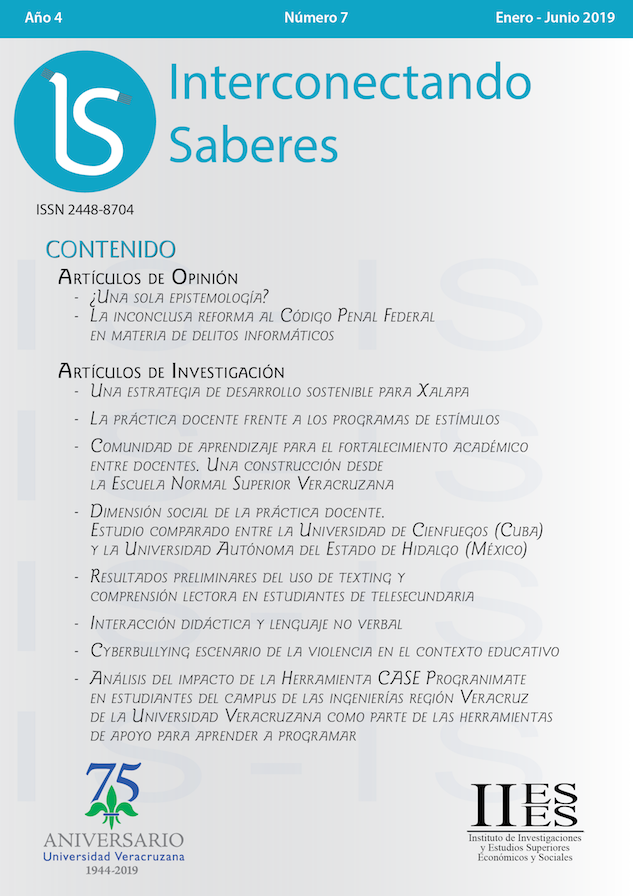Resumen
La incorporación de las TIC en el aula forma parte de las actividades que el docente debe realizar en su práctica para producir cambios en la forma en que enseña, el modelo ITIC-PD fue diseñado para identificar cambios en las diferentes dimensiones en las que puede segmentarse la labor docente. El objetivo de esta investigación es comparar los cambios que están surgiendo en dos universidades públicas latinoamericanas en la dimensión social, utilizando como instrumento un cuestionario con escala tipo Likert, y entrevistas a informantes clave. Los hallazgos identifican que aun cuando existen diferencias notables respecto a la infraestructura tecnológica dispuesta en cada institución educativa, el presuponer que su presencia conlleva una transformación de las prácticas es una falacia, ya que el acceso y la asimilación para usar las tecnologías digitales y no su simple presencia en el aula son lo que genera la metamorfosis de los procesos de enseñanza-aprendizaje.
Citas
Alfaro, A., Fernández, M., y Alvarado, R. (2014). El uso de las TIC en la formación permanente del profesorado para la mejora de su práctica docente, Revista científica electrónica de educación y comunicación en la sociedad del conocimiento, Época II, Núm. 14, recuperado de: http://www.ugr.es/~sevimeco/revistaeticanet/numero141/Articulos/Formato/190.pdf
Bereday, G. (1968). El método comparativo en pedagogía. Barcelona: Editorial Herder.
Bourdieu, P. (2012): La distinción. Criterio y bases sociales del gusto, Madrid, Editorial Taurus.
Bray, M. Adamson, B. y Mason, M. (2010). Educación comparada. Enfoques y Métodos. México: Granica.
Bray, M. y Thomas, R. (1995). Levels of comparision in educational studies: Different Insights literatures and the value of multilevel analisys. Harvard Educational Review, Vol 65, No. 63, pp. 472-490, recuperado de:http://hepgjournals.org/doi/abs/10.17763/haer.65.3.g3228437224v4877
Cabero, J. (2012). Las redes sociales en el entramado educativo de la Web. 2.0. En Navas, E. Web 2.0 Innovación e investigación educativa, pp. 21-28. Caracas: Univ. Metropolitana.
Cabero, J. (2014). Formación del profesorado universitario en TIC. Aplicación del Método Delphi para la selección de los contenidos formativos. Educación XX1, Vol. 17, No. 1, pp. 111-131, recuperado de: http://www.redalyc.org/pdf/706/70629509005.pdf
Casillas, M., Ramírez, A., Carvajal, M., y Valencia, K. (2016). La integración de México a la sociedad de la información. En C. E. Téllez (Ed.), Derecho y TIC. Vertientes actuales. México: Infotec.
Cela, J., Esteve, V., Mon, González, F. y Gisbert, M. (20127). El docente en la sociedad digital: una propuesta basada en la pedagogía transformativa y en la tecnología avanzada. Profesorado. Revista de Currículum y Formación de Profesorado, Vol. 21, No. 1, recuperado de: http://www.redalyc.org/html/567/56750681020/
Clayson, D. y Haley, D. (2013). An introduction to multitasking and texting: Prevalence and impact on grades and GPA in marketing classes. Journal of Marketing Education, No. 35, pp. 26–40, recuperado de: http://journals.sagepub.com/doi/10.1177/0273475312467339
Cook, T. y Rechardt, Ch. (1986). Métodos cualitativos y cuantitativos en investigación evaluativa. Madrid: Ediciones Morata.
Creswell, J. y Plano, V. (2011). Designing and conducting mixed methods research. Thousand Oaks, CA: Sage.
Denzin, N. y Lincoln, Y (2012). Manual de investigación cualitativa. Madrid: Gedisa.
Díaz, F. y Hernández, G. (2010). Estrategias docentes para un aprendizaje significativo. Una interpretación constructivista. México: Mc Graw Hill.
George, C. y Veytia, M. (2017). Nativos y migrantes digitales, riesgo de una conceptualización simplista, En Desafíos de la cultura digital para la educación. Chávez, B., González, R. y Lay, I. Jalisco: UDGvirtual, recuperado de: http://biblioteca.udgvirtual.udg.mx/eureka/pudgvirtual/desafios_cultura_digital.pdf
Glaser, B. y Strauss, A. (1967). The Discovery of Grounded Theory: strategies for qualitative research. Nueva York: Aldine de Gruyter.
Gould, S., Cox, A. y Brumby, D. (2016). Diminished control in crowdsourcing: An investigation of crowdworker multitasking behavior. ACM Transactions on Computer-Human Interaction, Vol. 23, No. 3, Article 19, recuperado de: http://discovery.ucl.ac.uk/1482232/1/gould-et-al-crowdsourced-interruption-tochi.final.pdf
Hilker, F. (1964). La pedagogie comparée. Introduction à son historie, sa théorie et sa practiqué. Paris: Institut Pédagogique National.
http://www.unesco.org/new/es/unesco/themes/icts/lifelong-learning/higher-education/
Landman, T. (2011). Política comparada: una introducción a su objeto y métodos de investigación. Madrid: Alianza Editorial.
Lizarazo, D. y Andión, M. (2013). Símbolos digitales. Representaciones de las TIC en la comunidad escolar. México: Siglo XXI Editores.
OEI (2018). Estudio sobre la inclusión de las TIC en los centros educativos de aulas fundación telefónica, Madrid: España, recuperado de: https://www.fundaciontelefonica.com/arte_cultura/publicaciones-listado/pagina-item-publicaciones/itempubli/635/
Ramírez, A. y Casillas, M. (2015). Los saberes digitales de los universitarios. En J. Micheli. Educación virtual y universidad, un modelo de evolución. pp. 77-106. Serie Estudios Biblioteca de Ciencias Sociales y Humanidades. México: Universidad Autónoma Metropolitana, recuperado de: https://www.uv.mx/personal/albramirez/files/2015/06/saberes_digitales_uam.pdf
Raventós, F. (1983). El fundamento de la metodología comparativa en educación. Edu¬car Pedagogía comparada. No. 3, pp. 61-75. Universidad Autónoma de Barcelona: Centro de Pedagogía Comparada. Recuperado de http://www.raco.cat/index.php/Educar/article/view/42058/89969.
Ravizza, S., Uitvlugt, M. y Fenn, K. (2016). Logged In and Zoned Out: How Laptop Internet Use Relates to Classroom Learning. Psychological Science, Vol. 1, No. 10. Michigan State University, Sage: Michigan, recuperado de: http://journals.sagepub.com/doi/abs/10.1177/0956797616677314?journalCode=pssa
Schriewer, J. (1993): El método comparativo y la necesidad de externalización: criterios metodológicos y conceptos sociológicos, en J. Schriewer y F. Pedró (Eds.), Manual de educación comparada (Vol. II) Teorías, investigaciones, perspectivas, pp. 189-251. Barcelona: Pomares-Corredor.
Simons, H. (2011). El estudio de caso: Teoría y práctica. Madrid: Morata.
Stake, R. (1998). Investigación con estudio de casos. Madrid: Morata.
Strauss, A. y Corbin, J. (2002). Bases de la investigación cualitativa. Técnicas y procedimientos para desarrollar la teoría fundamentada. Universidad de Antioquía: Colombia.
Vargas, A. (1995). Estadística descriptiva e inferencial. Servicio de publicaciones de la Universidad de Castilla-La Mancha: Madrid.

